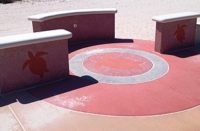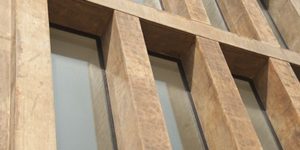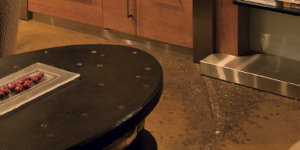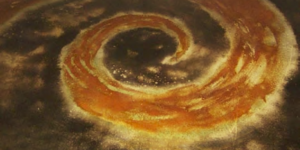
Some materials you handle as a concrete worker can be hazardous to your health, including the concrete itself. Wet concrete can burn your skin, while concrete dust can hurt your lungs.
Acid stain is comparatively pretty safe — but there are still some safety procedures you should consider.
While acid stains can cause burns, those are easy to avoid. However, there are other, more serious ways in which acid stain can be detrimental to your health.
Most acid stains consist of hydrochloric acid (also known also as muriatic acid) and various metallic salts as color agents. But the concentration of acid in them is weak, says Mike “the concretist” Miller. “Acid stains are pretty benign. Think about using lemon juice in the kitchen, or wine vinegar. It’s basically that level of acidity we are talking about. When you buy the stains you get one part muriatic acid to 10 parts water.”
Bob Torres, regional manager of L. M. Scofield Co., the oldest manufacturer of acid stains in the country, agrees. “The acid in acid stain is pretty minimal compared with the overall product, so direct contact with the skin won’t necessarily give you a physical burn. But,” he says, “the absorption of the metallic salts into your body isn’t good.”
Torres’ advice is that if you get anything from an acid bath or an etching product on your skin, you definitely don’t want to rub it. Just flush it with water, some baking soda and soap, which does two things: It removes the stain and metals, and it neutralizes any potential acid that could cause a skin irritation. If you get it in your eyes, however, flush only with a lot of water, and if there is any irritation go to the hospital.

“Acids can cause chemical burns that can turn into serious second- and even third-degree burns if they aren’t washed off when you feel the burn,” maintains Tom Ralston, owner of Tom Ralston Concrete, Santa Cruz, Calif. “But the real hazard is inhaling the finely atomized particles when you’re spraying acid stain. If you do it repeatedly you can get pulmonary edema, which is basically water in your lungs. Plus, your lungs can get burned from the hydrochloric acid base and the iron salts. It’s all nasty stuff to breathe in.”
Ralston has a detail crew that does nothing except seal concrete and acid stain. Each of them wears chemical-resistant gloves and P100 respirators. “At all of our weekly safety meetings we reiterate that when you’re saw-cutting, sandblasting, acid staining or acid etching, you must wear a respirator and chemical-resistant gear, because those particulates are dangerous to your nice pink lungs. Yet on every job site I’ll find a guy who won’t wear a respirator because it fogs up his glasses, or he has some other excuse.” There is no acceptable excuse, Ralston says.
Bob Harris, of the Decorative Concrete Institute, teaches safety in every course. “But,” he says, “it seems as though the younger generation (myself included when I was younger) feels they are invincible, without considering the long-term effects working in an unsafe environment can have. Although many of the basic safety concerns are elementary, you would be surprised how often workers put themselves in unsafe situations.”
Harris shares the story of an industry colleague who was teaching a class on acid staining and was not wearing protective eye gear. He did not check to make sure all of the fittings on his pump sprayer were secured, and as he was pressurizing the sprayer in front of his students, one of the fittings blew off and spewed acid stain into his eyes. The end result was a trip to the hospital to get his eyes flushed and a failing grade given to the teacher by his students.
To this point, Bob Torres notes that it’s important to use a composite or plastic sprayer that has acid-resistant seals made from Viton or a similar material. “The acid eats right through standard metal sprayers, and all of a sudden you’ll have acid spurting out of a little hole and shooting someone in the face,” he says.
Proper ventilation seems basic, but you’d be amazed how many people don’t even think about it. Bob Harris teaches students that doors and windows should be open on the job, and a floor fan can be really helpful to create air movement. “Without proper ventilation the overspray can create a vapor cloud that is harmful to breathe. So, whether inside or out, ventilators are basic equipment,” he says.
Miller says that when you’re dealing with acids, read the label, MSDS and technical data bulletin for each new product you take up. It’s there that the combination of metallic salts and concentration of muriatic acid will be listed, warning you of potential hazards.
Sometimes even the colorant affects your safety, he says. “For instance, the combination of hydrochloric acid and manganese chloride (the metallic salt used to produce blacks and browns) produces chlorine gas, which is produced under pressure when it’s in the container. If it’s not handled carefully it can go boom. At the very least you’re going to know you breathed in something you don’t ever want to breathe in. You could even pass out for a few seconds. If you’re wearing a respirator you won’t have to worry about it!”
Bob Torres observes that hydrochloric acid can be potentially explosive when mixed with water. Yes, all acid stains are mixed with water, but you never want to put a half gallon of stain into a 5-gallon bucket and then add fresh water on top, he says. “That’s when it could go boom. You want to do the opposite: Add the water first and then the stain or acid wash.”
For those always searching for safer methods to get their etch on, gelled acids are more easily controlled and can be applied on a vertical surface without any drip. “However, they can’t be sprayed or used to cover a massive area, so their use is limited,” Tom Ralston says.
Finally, when it comes to exterior spray applications, be cognizant of what an acid mist can do to the environment. Best results come from the application of several coats using a light fine mist, and when you spray the mist, the wind can catch the hydrochloric acid fog and distribute it below. It can have a harmful effect on everything from windows and sidewalks to parked cars, so think about what it can do to your health! Use proper respirators and acid-resistant protective gear and go home healthy.















